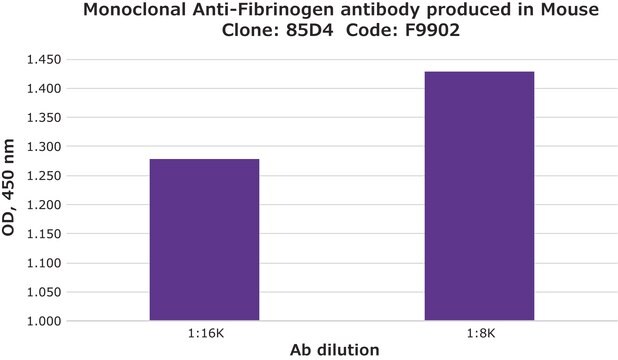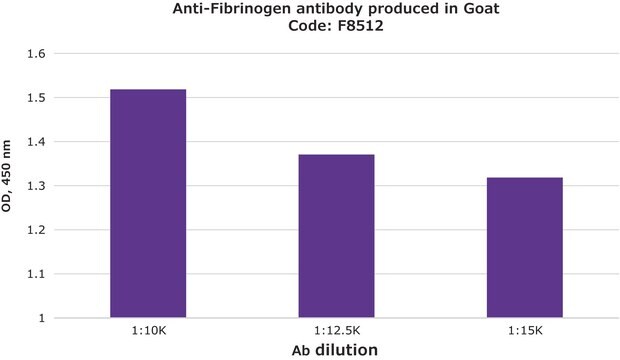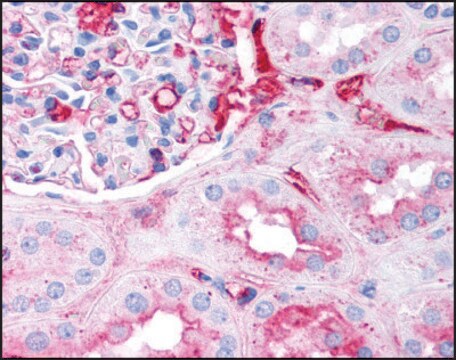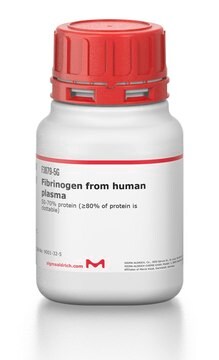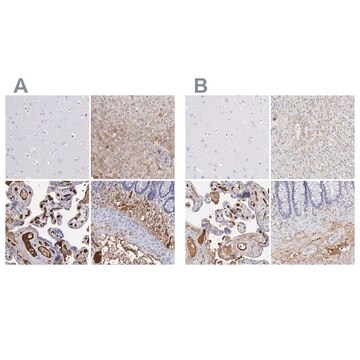F4639
Monoclonal Anti-Fibrinogen antibody produced in mouse
clone FG-21, ascites fluid
Autenticatiper visualizzare i prezzi riservati alla tua organizzazione & contrattuali
About This Item
Prodotti consigliati
Origine biologica
mouse
Coniugato
unconjugated
Forma dell’anticorpo
ascites fluid
Tipo di anticorpo
primary antibodies
Clone
FG-21, monoclonal
contiene
15 mM sodium azide
Reattività contro le specie
human, baboon
tecniche
indirect ELISA: 1:4,000
Isotipo
IgG2a
N° accesso UniProt
Condizioni di spedizione
dry ice
Temperatura di conservazione
−20°C
modifica post-traduzionali bersaglio
unmodified
Descrizione generale
Fibrinogen, is a thrombin-coagulable soluble plasma 340kDa glycoprotein, composed of paired sets of three subunits i.e. α, β, γ. Among three subunits, β and γ subunits contain one N-glycosylation site, which is occupied by a biantennary N-glycan. It contains three pairs of disulfide bonded chains called α, β, γ which further folded into four structural domains: the D, E, connector and the COOH-terminal region of the Aα chain.
Monoclonal Anti-Fibrinogen (mouse IgG2a isotype) is derived from the hybridoma produced by the fusion of mouse myeloma cells and splenocytes from an immunized mouse.
Specificità
The antibody is specific for human fibrinogen and recognizes an epitope sensitive to reduction commonly used in immunoblotting assays. It also reacts with synthetic human fibrinopeptides A and B, fibrinogen related peptides and baboon fibrinogen. No cross-reactivity with bovine, pig, sheep, horse, dog, goat, rabbit, guinea pig, or rat is observed.
Immunogeno
purified haptoglobin from pooled human plasma containing the three major haptotypes.
Applicazioni
Monoclonal Anti-Fibrinogen antibody produced in mouse has been used in:
- enzyme linked immunosorbent assay (ELISA)
- immunoblotting
- fibrinogen adsorption assay
Azioni biochim/fisiol
Fibrinogen, a blood coagulation protein, is regarded as the central protein in the blood coagulation system.Fibrinogen plays a crucial role in protecting the vascular network against the loss of blood after tissue injury.
Plasmin attacks the Aα chain COOH domain to produce the heterogeneous fragment X. After a series of degradation, it ended with terminal digestion products: fragments D and E which represent the major globular domains in fibrinogen. Mutations in this gene leads to several disorders including hypofibrinogenemia, afibrinogenemia.
Esclusione di responsabilità
Unless otherwise stated in our catalog or other company documentation accompanying the product(s), our products are intended for research use only and are not to be used for any other purpose, which includes but is not limited to, unauthorized commercial uses, in vitro diagnostic uses, ex vivo or in vivo therapeutic uses or any type of consumption or application to humans or animals.
Non trovi il prodotto giusto?
Prova il nostro Motore di ricerca dei prodotti.
Codice della classe di stoccaggio
10 - Combustible liquids
Classe di pericolosità dell'acqua (WGK)
nwg
Punto d’infiammabilità (°F)
Not applicable
Punto d’infiammabilità (°C)
Not applicable
Scegli una delle versioni più recenti:
Possiedi già questo prodotto?
I documenti relativi ai prodotti acquistati recentemente sono disponibili nell’Archivio dei documenti.
Preservation of hematopoietic stem and progenitor cells from umbilical cord blood stored in a surface derivatized with polymer nanosegments
Higuchi A, et al.
Biomacromolecules, 9(2), 634-639 (2008)
Akon Higuchi et al.
Biomaterials, 24(19), 3235-3245 (2003-05-24)
We examined plasma protein adsorption and platelet adhesion to polysulfone (PSf) flat membranes coated with Pluronic with varying polyethylene oxide (PEO) block length. Adsorption of albumin, globulin and fibrinogen to Pluronic-coated PSf membranes was independent of plasma dilution when concentrations
Identification of Apo-A1 as a biomarker for early diagnosis of bladder transitional cell carcinoma
Li H, et al.
Proteome Science, 9(1), 21-21 (2011)
N E Kirschbaum et al.
The Journal of biological chemistry, 265(23), 13669-13676 (1990-08-15)
The COOH-terminal portion of the A alpha chain of human fibrinogen is highly susceptible to proteolytic degradation. This property has prevented isolation of the COOH-terminal domain of fibrinogen for the direct investigation of its functional characteristics. Human fibrinogen was degraded
Y Fang et al.
Haemophilia : the official journal of the World Federation of Hemophilia, 12(6), 615-620 (2006-11-07)
Congenital afibrinogenaemia is a rare autosomal recessive disorder, characterized by the complete absence or extremely reduced level of fibrinogen (Fg). We attempted to analyse the phenotype and genotype in two Chinese families with congenital afibrinogenaemia. Coagulation studies including activated partial
Il team dei nostri ricercatori vanta grande esperienza in tutte le aree della ricerca quali Life Science, scienza dei materiali, sintesi chimica, cromatografia, discipline analitiche, ecc..
Contatta l'Assistenza Tecnica.